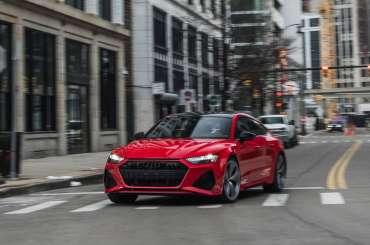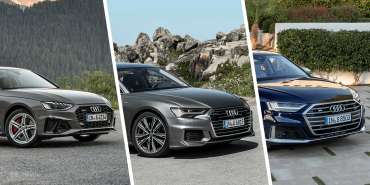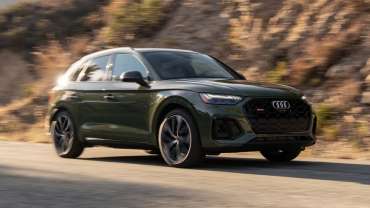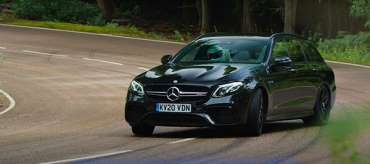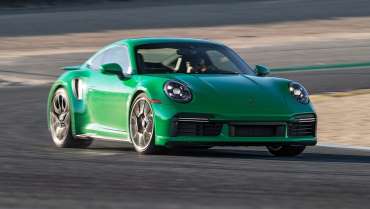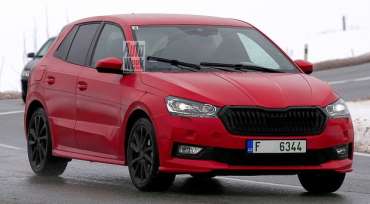
Worldcarblog.com
2021 Audi RS7 Sportback Gets Caught in a Sibling Rivalry
Despite its soul-stirring performance, Audi's redesigned 591-hp RS7 makes a case for the less-expensive RS6 Avant wagon.
After a brief hiatus from the United States market, Audi's fiery RS7 Sportback returns for 2021 in fighting form. Delivering big doses of both speed and refinement, the new car's stonking performance sacrifices little comfort for its driver. But it's not the only practical hot-rod hatchback that Audi offers these days, and therein lies the RS7's greatest issue.
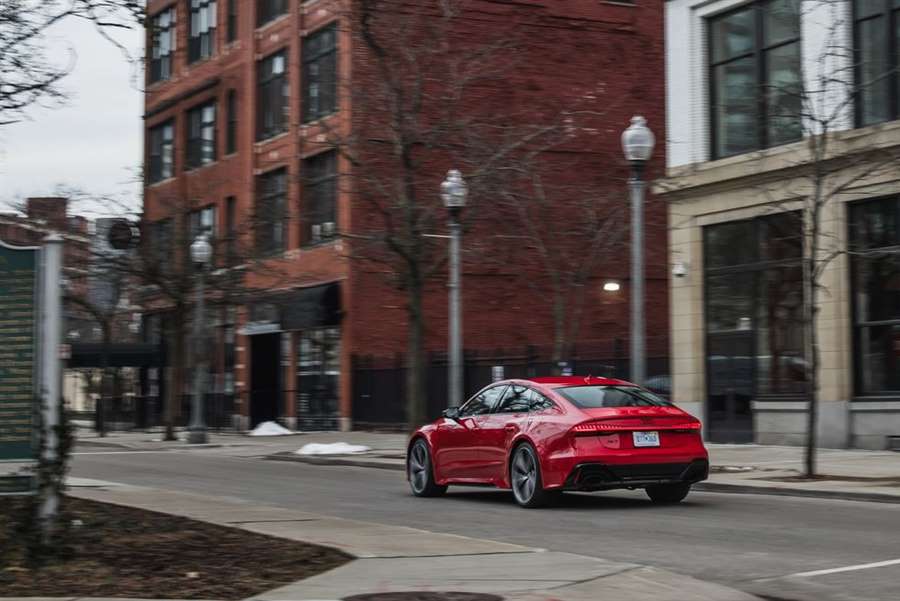
HIGHS: Effortless speed, impressive ride comfort, menacing curb appeal.
The new RS7 is once again motivated by the Volkswagen Group's venerable—and versatile—twin-turbocharged 4.0-liter V-8 that also can be found under the hoods of various Bentley, Lamborghini, and Porsche models. Output in this version is a strong 591 horsepower and 590 pound-feet of torque. If those figures sound familiar, that's because they're the same as those of the Audi RS6 Avant station wagon, which is mechanically identical to the RS7 yet offers more cargo space—30 cubic feet versus the RS7's 25. We also think the longer-roof RS6 looks better, but we're suckers for wagons. Compared to the previous RS7, this 4.0-liter wears turbos featuring larger compressor wheels. Thanks largely to an additional 2.9 pounds of boost over the previous standard model, the RS7's horsepower and torque ratings swell by 30 and 77, respectively. As with the RS6, the RS7 features a conventional eight-speed automatic transmission and standard all-wheel drive, or Quattro if you're into trade names.
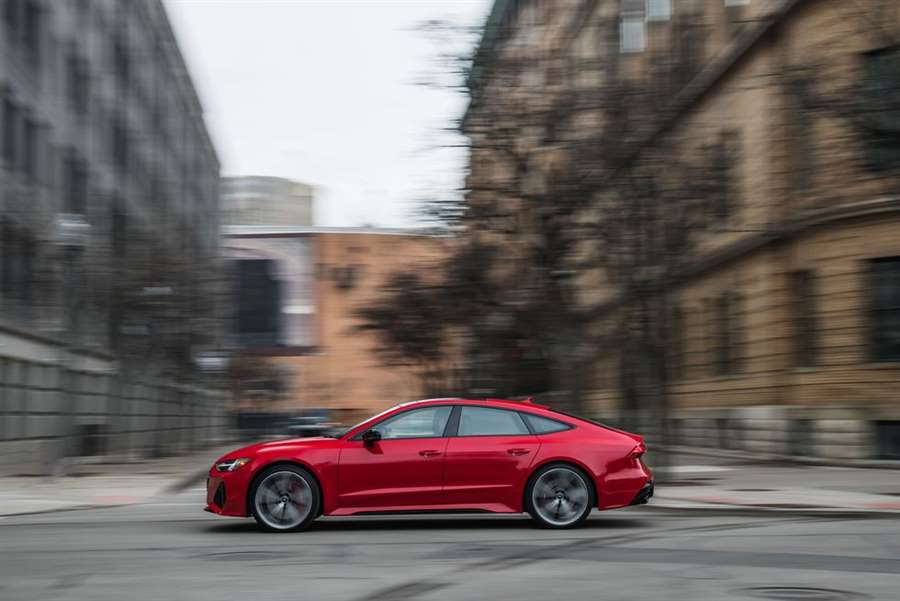
Audi RS7 Has Dynamite Looks and Big Power
On paper, the latest RS7 is not as impressive as its predecessor's hottest variant, the 605-hp RS7 Performance. Yet, despite the new car weighing an additional 460 pounds, it can catapult its 4947-pound girth to 60 mph in a mere 3.0 seconds, which is a tenth of a second quicker than before. Stay on the throttle and it posts a similar 11.3-second quarter-mile time but with a 3-mph slower trap speed (122 mph), which is indicative of its extra bulk. The 2021 RS7's porkiness is also on display in both the 30-to-50- and 50-to-70-mph top-gear acceleration tests, where it trails the RS7 Performance by 0.4 and 0.5 second, respectively. Well, pokiness or a less aggressive transmission map. For comparison, the RS6 Avant gets to 60 in 3.1 seconds and covers the quarter-mile in 11.5 seconds at 120 mph.
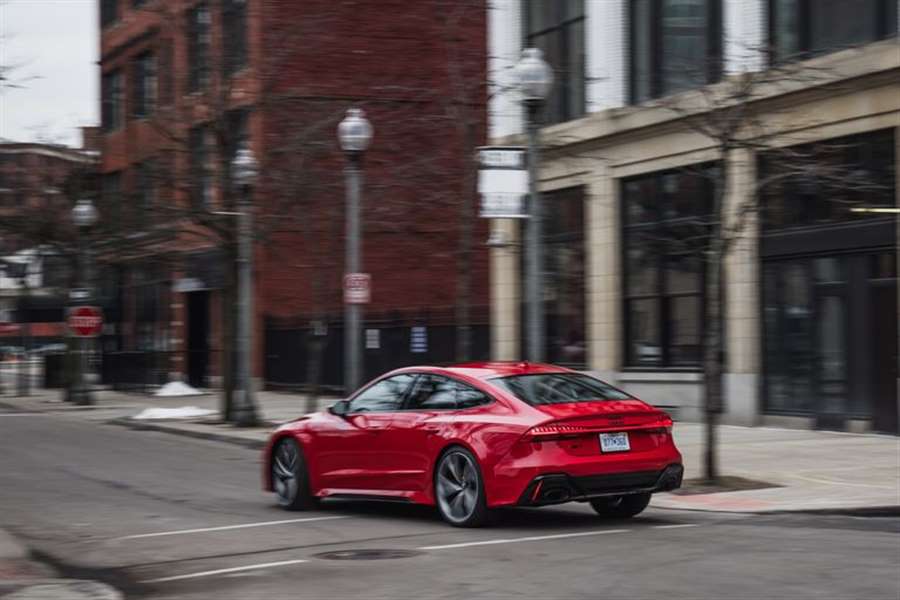
LOWS: Subdued exhaust note, seriously heavy, an RS6 Avant is both cheaper and more practical.
Making the most of the RS7's acceleration on the street is easy, thanks to a neat trick we discovered with the car's advanced electronics. When fitted with Audi's Intersection-assist feature (part of the $2250 Driver Assistance package), the RS7 communicates with intersections that are V2I (vehicle-to-infrastructure) compatible. Activate this at a stoplight and a countdown timer illuminates in the standard 12.3-inch digital instrument cluster, indicating when the light will turn green. Depress one of the RS Mode buttons on the RS7's steering wheel to summon launch control and the car's customizable drive modes, stand on the brake and accelerator, and then release the brake for a max-thrust hole shot.
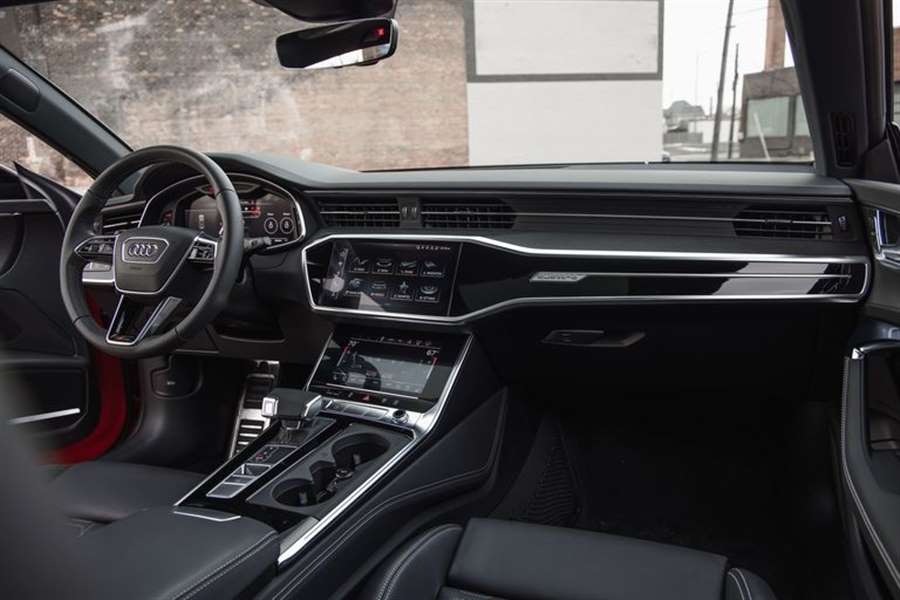
The RS7 is more than a stoplight racer, though. With broad shoulders that are 1.7 inches wider than the lesser S7's, plus its blacked-out maw and exterior trim, this Audi looks stunningly mean. But it also grabs attention, which is problematic when triple-digit speeds can be summoned almost by thought. That it also brings an impressive level of refinement doesn't help matters. We imagine much of its weight gain comes from significantly more sound-deadening material, as our test car's calm and serene cabin reduced the full-throttle noise from the $1000 Sport exhaust to a distant, 79-decibel bark. Ride comfort on the optional 22-inch wheels with 30-series Pirelli P Zero PZ4 summer tires is excellent, the standard air springs shrugging off even the worst of Michigan's poorly maintained roads.
Despite carrying 56.1 percent of its mass on its front wheels, the RS7 feels surprisingly balanced. When pushed hard into corners, the standard rear-wheel steering helps its driver maintain a smooth, tight line by rotating its rear end. Its ability to change directions is bolstered by a torque-vectoring rear differential, which helps with yaw by splitting the rear axle's torque unevenly. In Dynamic mode, the RS7 hunkers down by 0.4 inch and circles the skidpad with a solid 0.95 g of lateral adhesion. When it's time to slow down, massive 16.5-inch iron front rotors clamped by 10-piston calipers effortlessly shed the car's forward momentum. Stops from 70 mph take a scant 151 feet. While our car didn't feature them, carbon-ceramic brakes are available for $8500 and have the added benefit of upping the governed top speed from 155 mph to a claimed 190.
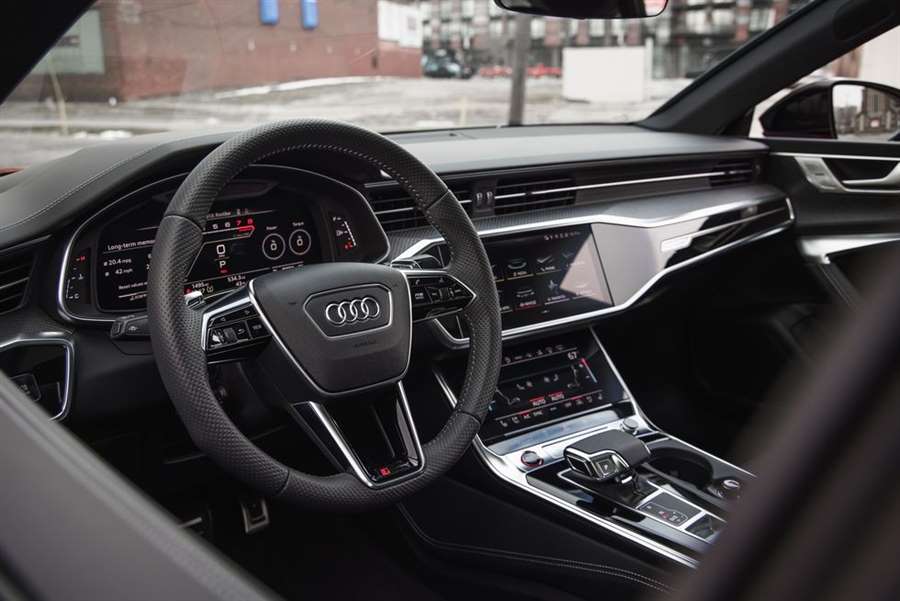
The performance and presence of the Audi RS7 is intoxicating enough for us to almost forget that the RS6 Avant exists. But one glance at the RS7's $115,045 base price puts the two cars in perspective. For $5000 less, Audi's RS wagon posts nearly identical performance results, has seating for five versus the RS7's four, and is more capacious in back. For those smitten with the RS7's sleeker profile, it is an awesome machine. But we know where our money would go.
Source: caranddriver.com
Audi announces shutdown of A4, A6 and A8 models!
Audi has set a date for the suspension of the A4 and A6 models powered by internal combustion engines. The same goes for the Audi A8. The Bavarians obviously do not want to invest significant sums of money even in the development of models from the plug-in hybrid segment. The decisions of the company's leaders represent the cornerstone for the realization of the idea of Audi CEO Marcus Dysman, who wants this brand to leave the production of conventional cars.
The mentioned Disman has been at the helm of Audi for a shorter period of one year, and the German Manager Magazine reports that its plan for the development of the brand implies that the new generations of A4 and A6 sedans will be presented again from 2023, shortly after electric editions. However, Audi doesn’t even want conventional mid-size sedan variants to be in the sales mix for the rest of the life cycle of that generation of sedans. So, the end of the offer for A4 and A6 will come before we reach 2030.
When it comes to the limousine flagship marked A8, it should be said that the premiere of the restyled version is expected by the end of this year. It should also be the last resort to keep the big sedan current, and Audi also does not want to artificially extend the life of this vehicle even by offering it as a representative of the PHEV segment.
Manager Magazine reports that Disman already perceives the mentioned models as "living dead", indirectly quoting him, ie transmitting his words in a slightly freer translation, that the company's policy is to order the suspension of the promotion of old technology after the federal elections planned for autumn this year. . The Bavarians believe that customers will simply lose interest in conventional Audi models after that.
Almost two weeks ago, the head of Audi told another German business weekly, Wirtschaftswoche, that the company is currently working on a concrete plan that envisages phasing out and shutting down the offer of models powered by internal combustion engines, which will be a process that ends "in the next ten, maybe fifteen years".
The focus of teams of experts employed by the company from Ingolstadt is increasingly occupied by purely electric models. Disman further emphasized the importance of battery models for the premium brand by declaring work on the Artemis project, immediately after he took the chair of the brand’s commander-in-chief. According to a report published by Automobilwoche at the very beginning of the year, the first model developed under the auspices of the Artemis project will be presented at the IAA event taking place this fall.
Serial production of the model is scheduled for the end of 2024. Disman recently said that the model will not be a large sedan or a large SUV, which would eventually be placed in a class above the A8 or Q7: "It will be a new category vehicle and we will not tie it for symbol A, nor for index Q. ”
Finally, Audi has entered the premium electric vehicle market with its e-tron models.
2021 Audi SQ5 First Test Review: “S” Is for “Sporty” and “Suave”
Comfortable when you need it, punchy when you want it.
With SUVs being so popular now, manufacturers have the challenge of fitting multiple models into a multitude of niches to satisfy all kinds of customers. Take Audi, for example, whose Q5 represents about 25 percent of the marque's U.S. sales. Part of that has to do with the model's three very different powertrain variants: the regular Q5 45 TFSI, the gasoline-electric plug-in hybrid Q5 55 TFSI e, and the dynamic SQ5. In the hottest segment of the game, you gotta satisfy everyone.
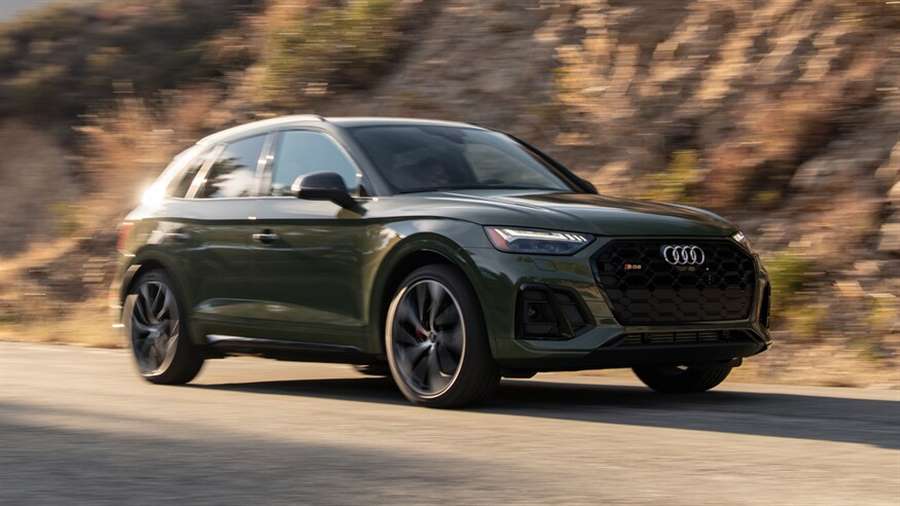
The 2021 Audi Q5 lineup gets a midcycle refresh that slightly changes its appearance inside and out, not to mention slightly boosts the model's performance. The 2021 SQ5, which we'll focus on in this review, improves upon the 2020 model, and after taking it to the track, we can confirm it also handles like a champ on our figure-eight course.
2021 Audi SQ5: The Numbers
In our testing, the turbocharged 3.0-liter V-6 that puts down 349 hp and 369 lb-ft of torque launched the SQ5 from 0 to 60 mph in 4.7 seconds, exactly the same time Audi got with its own stopwatches. The SQ5 also completed the quarter mile in 13.4 seconds at 102.9 mph. Those are pretty good numbers for a 4,400-pound SUV and it means the SQ5 can stay neck and neck with the competition. The last Mercedes-AMG GLC43 we tested—a 2017 model—got to 60 mph in the same 4.7 seconds and crossed the quarter mile in 13.4 seconds at 104.3 mph. Talk about being competitive. Since then, however, Mercedes has added 23 horses to the GLC43, which now makes 385 hp (torque remains the same at 384 lb-ft). We have yet to test an updated GLC43, so we'll have to wait and see how much faster (if any) it is.
Road test editor Chris Walton was impressed by the SQ5's handling. "Wow! What a delight on the figure eight," he said. "Really, a tremendously fun experience that I was not anticipating. Porsche levels of fun and predictability."
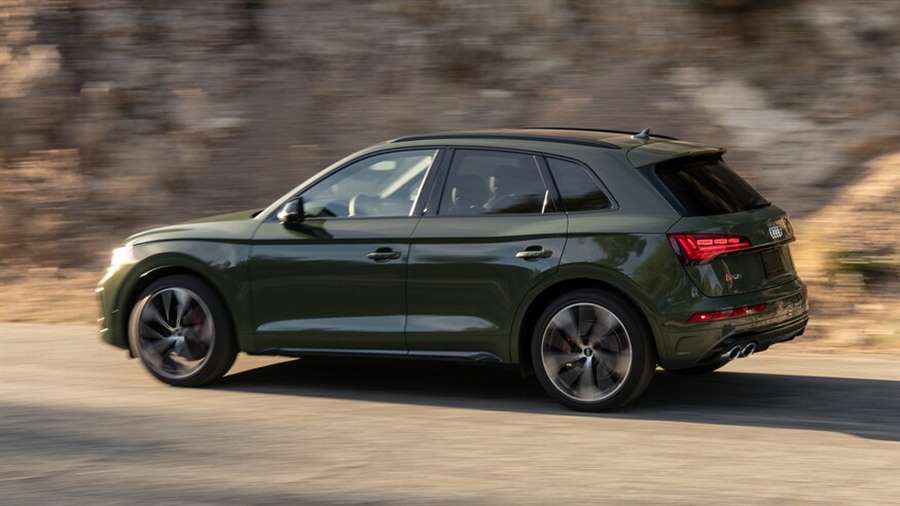
Whether it's on the track or the streets, the 2021 Audi SQ5 is fun to drive. Like we said in our First Drive, the SQ5 feels more like a hot hatch than a hot SUV, with limited body roll and sharp steering response. On twisty roads, the SQ5 leans in nicely, its tires maintaining good grip and giving you the confidence to push the SUV even harder. The low-end torque allows the SQ5 to pull itself out of corners with ease, but the transmission takes a bit of time to downshift, even in Dynamic mode. At least Audi fits the SQ5 with shift paddles, which allow the driver to override the gearbox's lethargic nature.
You're most likely buying an SQ5 because you want more power, but when you want to cruise peacefully, this Audi also delivers. Despite its 21-inch wheels, the SQ5's ride is settled and peaceful on the freeway. When we drove about Portuguese Bend, an area of the Palos Verdes Peninsula in Southern California where frequent land movements perpetually rumple the pavement, we noted the Audi's suspension handled medium undulations well.
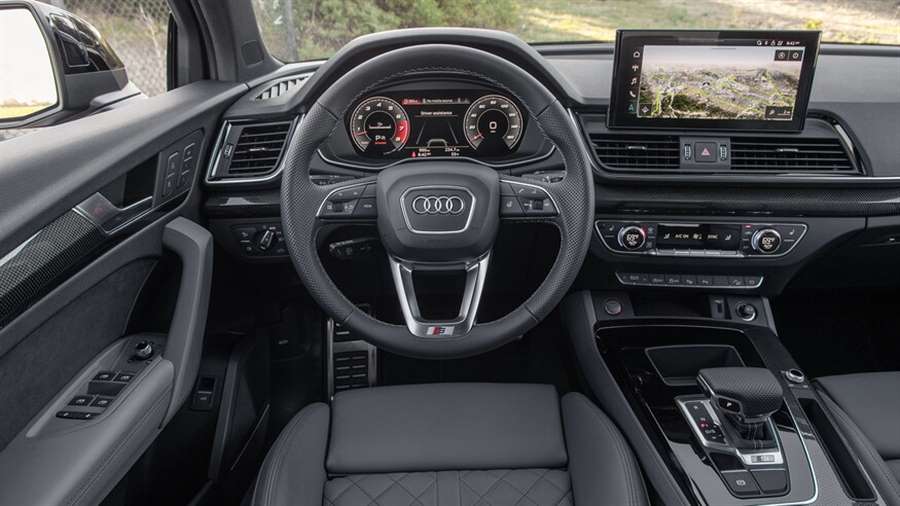
2021 Audi SQ5: Inside The Beast
You'll know you're in the SQ5 thanks to the number of badges located about the cabin. From the steering wheel to the shifter to the seats, the abundant S logos visually differentiate the SQ5 from its less powerful siblings. Besides that, all Q5 and SQ5 models come with the same 10.1-inch touchscreen infotainment system that's compatible with wireless Apple CarPlay and Android Auto. This screen replaces the priorly available 7.0- and 8.3-inch displays and is located within easy reach of the driver. The MIB3 infotainment system is easy to use and fast to respond, and it now adds a voice control system that learns and recognizes natural commands for vehicle controls.
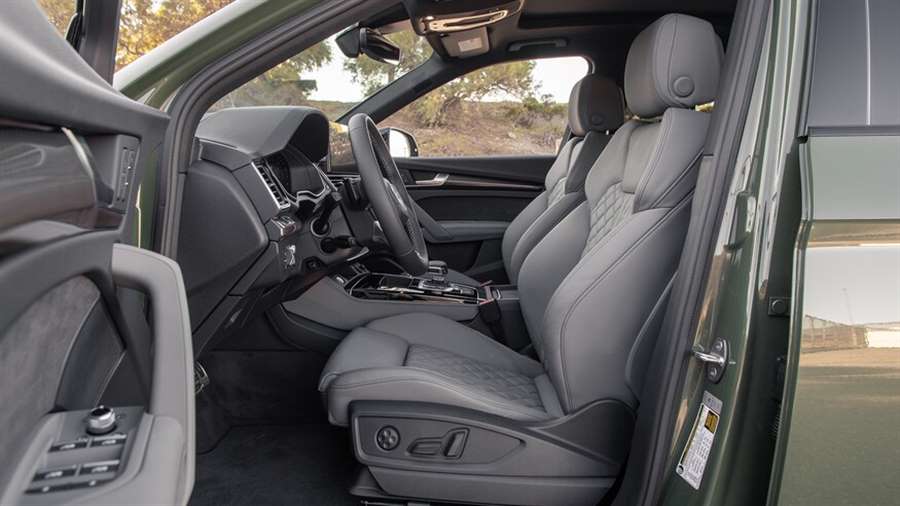
Although the SQ5 (as well as its Q5 stablemates) doesn't get the fancy dual-screen center console found in Audi's bigger models, such as the Q7 and Q8, the cabin still feels tech-savvy. A 12.3-inch digital gauge cluster (or Virtual Cockpit in Audi-speak) is enhanced with a better resolution that makes the setup's Google Satellite images even crisper. Our test car included the Prestige package and came with the optional color head-up display. The 19-speaker Bang & Olufsen premium sound system had us cranking up the volume every time we played our favorite songs.
Interior space is generally decent. The biggest compromise is to second-row foot room due to the bulky drivetrain hump. Other than that, though, there's plenty of space for adults. Rear-seat passengers will appreciate the airy cabin thanks to the large windows, but the biggest downside is that the seats do not fold in a fully flat position.
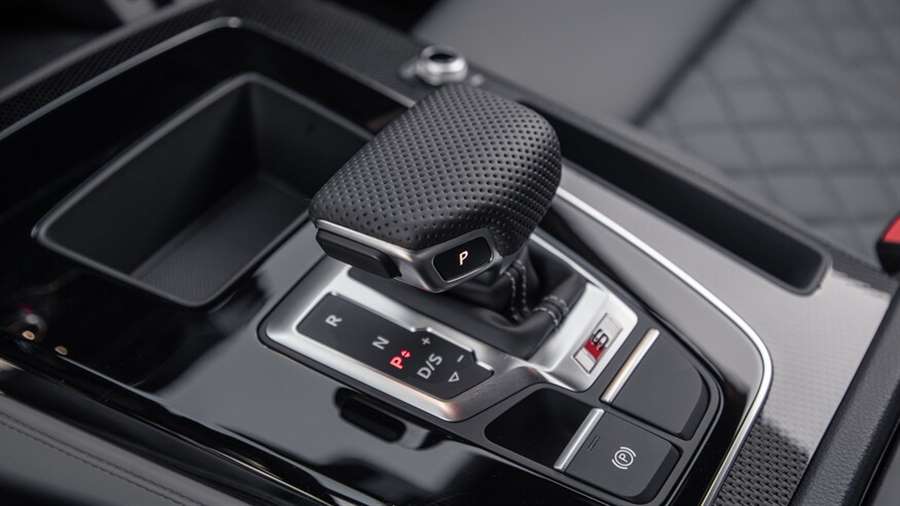
2021 Audi SQ5: Worth The Cost?
The updated SQ5 brings a fresh design inside and out while balancing dynamics and refinement for everyday driving. It's a great option for those who want more punch than the Q5 offers. Plus, with a starting price of $53,995, it's a reasonable value—at least in its base form. Prices escalate quickly, though, with our top-of-the-line SQ5 with the Prestige package stickering for $71,790.
The SQ5's number one mission is delivering a fun driving experience. This Audi not only does that, but it also provides a suave ride when you want it. Few SUVs manage to do this as well as the SQ5 does.
Source: motortrend.com
They demolished a garage in Sarajevo and found a Fiat 850 Coupe that had been parked for 30 years
An old Fiat 850 Coupe was found during the demolition of an old garage in the Sarajevo neighborhood of Alifakovac.
The car was in the garage for more than 30 years, and it was found when the workers demolished the garage, "Avaz" writes.

The price of this old-timer, if it was restored, would be above 30,000 KM (15,340 euros).
The car could end up in the trash because its owner passed away.
Mercedes-AMG E 63 Estate Stig Drifts
They say that he once did the Cannonball run on a unicycle, and that he broke the record by doing so. Also, he just can’t seem to stop drifting the cars he gets a hold of, and his newest conquest is a Mercedes-AMG E63 Station Wagon. We guess the AMG part of that sentence kind of makes everything click together.
Now, in the world of motorsports, you rarely get to see a station wagon competing alongside other. regular cars. But there are exceptions indeed. Like the globally acclaimed Volvo 850 back in the day, that competed in the Touring Car Series. Also, in drifting, there have been several pro drifters that felt the need to make a statement by competing in such a large body type of vehicle.
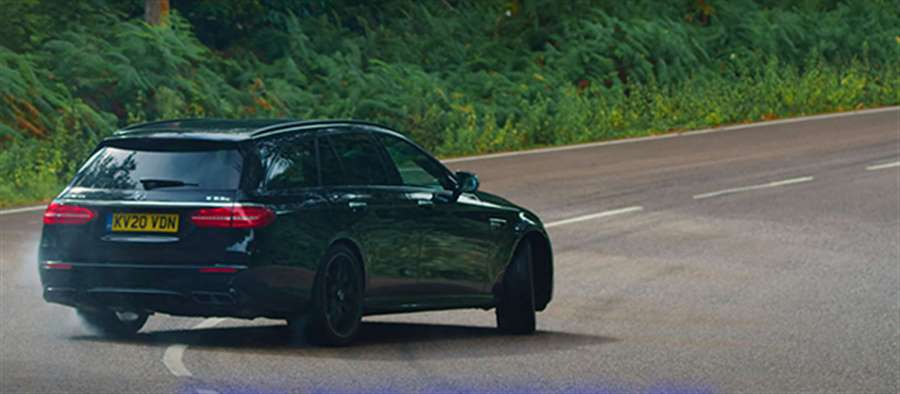
This would be the second time the Stig is checking out the sideways going capabilities of a Mercedes Benz in the new series, and the first one, the AMG C63 Black Series, was quite impressive, albeit a bit slouchy. This time things do look like they might be slightly easier, as the longer wheelbase should allow for a more stable slide, and the engine is now turbocharged, providing copious amounts of torque to play with.
The AMG E63 comes with a 4.0-liter turbocharged V8, which gives the driver access to a whopping 603 horsepower and 627 lb-ft (850 Nm) of torque. But weight has gone up for this attempt, as compared to the smaller C63, with the E class weighing 628 lbs (285 kg) more, which is not to be taken lightly.
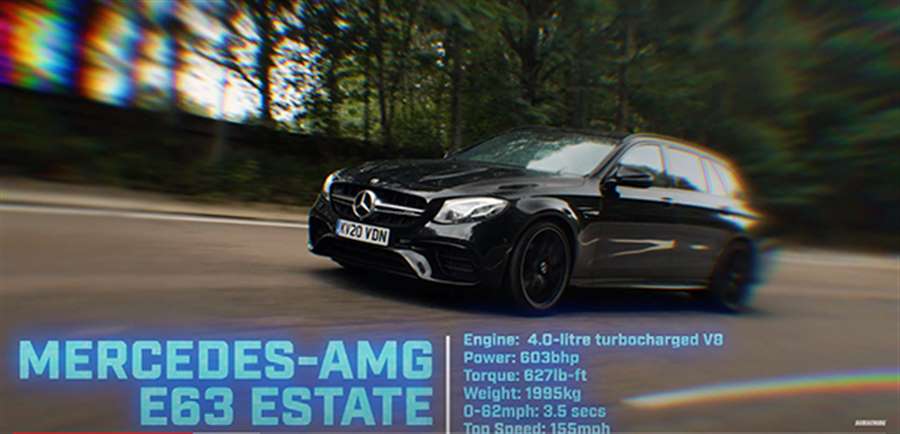
As expected, the long wheelbase does the trick, and the car looks quite good while going sideways, leaving just enough room to imagine what this vehicle could do after a massive weight loss and the proper drivetrain upgrades. That’s if anyone is enthusiastic enough to actually turn a nearly $100,000 Mercedes into an actual pro drift machine. Read more > https://mercedes-world.com/e-class/mercedes-amg-e-63-estate-drifts
Source: mercedes-world.com
2021 Porsche 911 Turbo S First Test: Sets the World on Fire
The blazing Turbo S is the second-quickest production car MotorTrend has ever tested.
The target: 0-60 mph in 2.3 seconds. That's the record and the bar by which all other production cars will be measured. Only two have ever accelerated to 60 mph so quickly, the 2017 Tesla Model S P100D and now, the 2021 Porsche 911 Turbo S we tested recently.
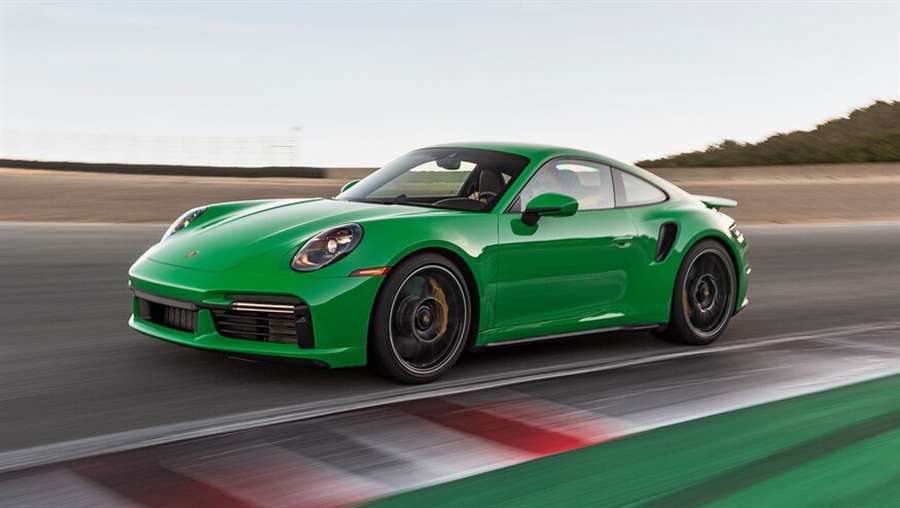
If you haven't noticed, we don't do ties at MotorTrend; every comparison has to have a winner. To find one, I asked road test editor Chris Walton to go to the electron microscope and scrutinize the results. Our 20-hertz Vbox GPS data logger measures a vehicle's position 20 times per second to give us extremely accurate results, but we round to the nearest 10th of a second for our published results. This rarely causes an issue, but it matters in this case.
Direct from the data file, the new 2021 Porsche 911 Turbo S needs only 2.348666958 seconds to hit 60 mph from a standstill. The Tesla was infinitesimally quicker, needing just 2.275507139 seconds. Holster your calculator, that's a difference of just 0.073159819 second. An actual blink of the eye takes 0.1 to 0.4 seconds, per Harvard Medical School.
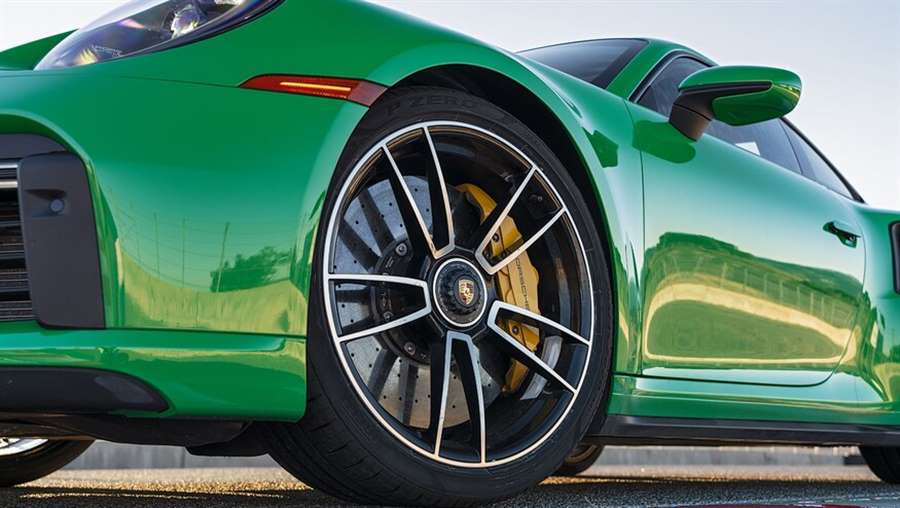
It's worth noting that although the Vbox gives data to the ninth decimal place, the company officially certifies the accuracy to 0.01 second. That puts the Tesla at 2.28 seconds and the Porsche at a 2.35-second time that rounds down.
Porsche Vs. Tesla
Don't think this means the Tesla will win a proper drag race, though. The Model S gets the holeshot, hitting 30 mph in 0.87 second to the Porsche's 0.94, but it starts to lose steam at higher speeds. A 10.5-second quarter mile at 125.0 mph is ludicrously quick for a production car on street tires, but it's not quick enough to beat a 2021 Porsche 911 Turbo S at the test track. The Porsche might launch fractionally softer, but once it's moving the 911 will run down the Tesla before the finish line with a 10.3-second quarter mile and a trap speed of 132.3 mph.
It's worth dwelling on the spec chart a little longer here. The quickest production cars MotorTrend has ever tested are a 680-hp, 4,891-pound battery-electric sedan, and now a 640-hp, 3,628-pound twin-turbo six-cylinder coupe. Neither is the lightest in its class by a long shot nor are they even close to being the most powerful. Neither wore the world's stickiest street tires: the Tesla rode on Michelin Pilot Super Sports, the 911 on Pirelli P Zeros. What these cars are, then, are two of the best-engineered and best-programmed, factory-built, all-wheel-drive, street-legal drag racers in America.
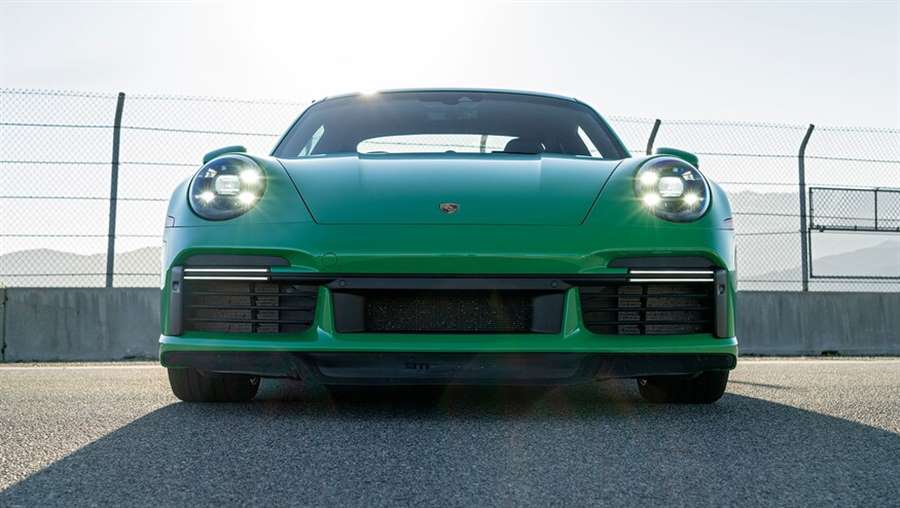
Of course, the 2021 Porsche 911 Turbo S we tested does a lot more than drag race. Keep looking down the chart, and you'll see it stops from 60 mph in 97 feet, which is supercar territory but not a record. Remember, that's on plain old P Zeros, not Corsas or Trofeos, which makes its performance more impressive.
The skidpad and figure-eight tests tell the same story. Achieving 1.10 average lateral gs on the skidpad is a crazy number, as is a 22.5-second figure-eight lap at 0.96 average cumulative g. Those are both in the top 10 all-time, again on regular Pirelli P Zeros. Put this monster Porsche Turbo S on a racetrack such as WeatherTech Raceway Laguna Seca, and, despite its tires, it'll put down a lap time within 0.7 second of a 711-hp Ferrari F8 Tributo.
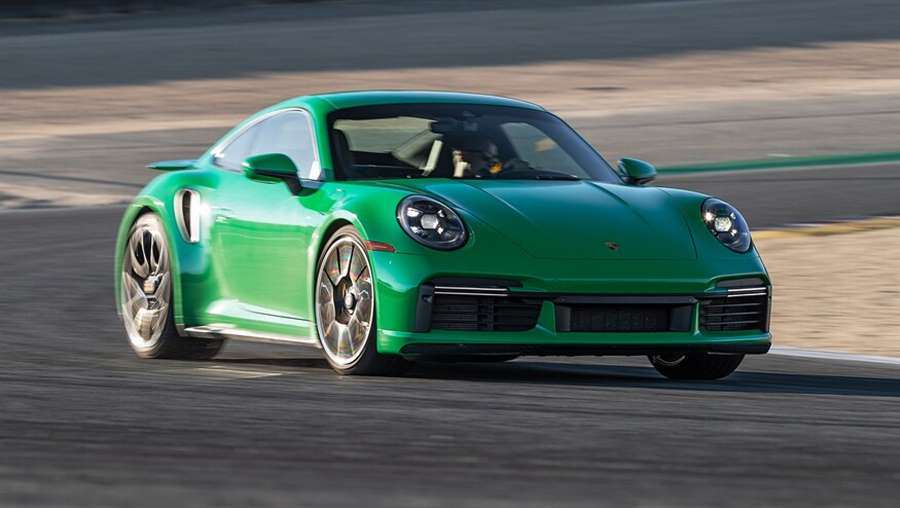
(Nearly) Unmatched Performance
What this 2021 Porsche 911 Turbo S is capable of when tested to its limits, objectively speaking, is nearly unmatched. And anyone who can come up with $204,850 can walk into a Porsche store today and buy one (technically, $211,380 including just the performance options on our test car).
Subjectively speaking, it's nearly as superlative. On the road, the Turbo S is pure magic. The way it moves feels organic, like the way an athlete moves, or a wild animal. Drivers of every skill level are immediately comfortable driving way, way over the speed limit—and right to their, and the car's, limits. Read that again. A car that comes within a hair of setting performance records across the board is also incredibly confidence-inspiring and easy to drive quickly, despite relying on a strong sports-car tire rather than a proper supercar tire.
The 2021 Porsche 911 Turbo S does have a limit, though. Blame the tires, blame that Turbo genealogy, but for as much Porsche GT personality as it has on the street, the 911 Turbo S loses something on the track. It becomes a bit cold and clinical on a road course. Would a set of Trofeos or Pilot Sport Cup 2s fix that? We'd love to find out. Either way, this test proved it already nips at the heels of the mighty, previous-generation 911 GT2 RS. Give it real running shoes, Porsche, and let's find out.
Source: motortrend
Recorded new Skoda Fabia
The official announcement from Škoda arrived in September last year that the new, fourth generation Fabia will be on sale during 2021, and then it was confirmed that its station wagon version (Fabia Combi) will also get a successor.
The current, third generation Fabia was promoted in 2014 at the Paris Motor Show, while in 2018, an updated version of it was shown at the Geneva Motor Show.
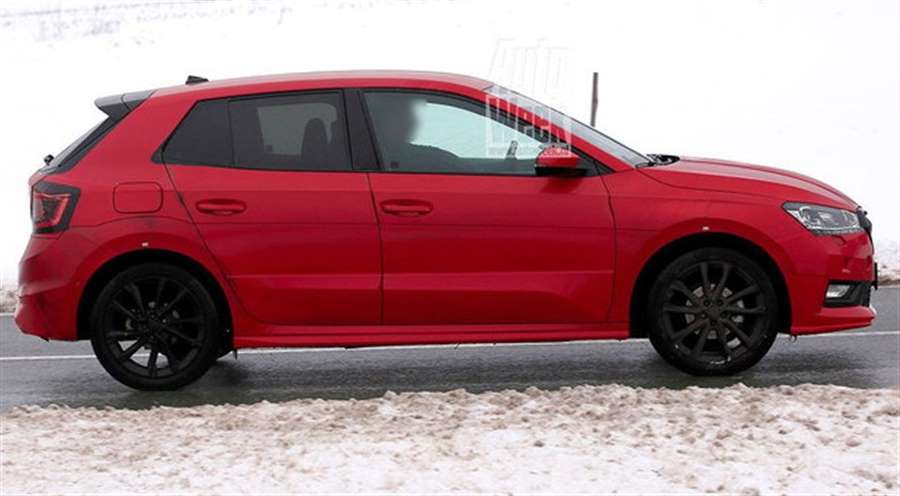
Still, given the innovations in the B segment (the new Renault Clio, the new generation Peugeot 208, the Opel Corsa, the Hyundai i20 and the Toyota Yaris), it’s time for bigger changes.
With a more striking look modeled on the brand's newer models (Scala, Kamiq, Octavia), the new Fabia will be built on the MQB A0 platform, and will also get a more modern interior and advanced technology.
Some information says that the car will be slightly wider, as well as that the spaciousness in the cabin will remain at a level similar to the current model so that the Fabia does not get too close to the larger Scala. Still, that will be enough to be one of the most spacious cars in its class. Also, the trunk should be slightly larger than it is now.
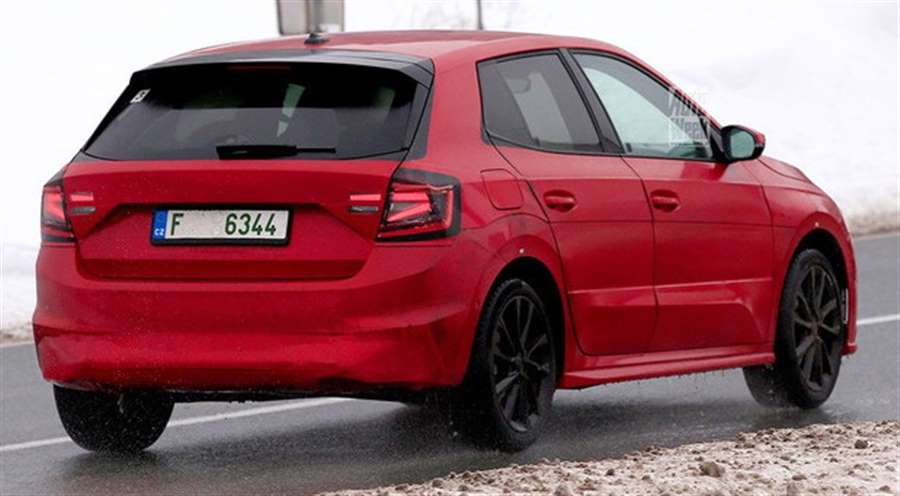
A wider wheelbase, better sound insulation, better quality materials in the interior, richer equipment, as well as a digital instrument panel (for more expensive versions) and an infotainment system with a screen of up to 9.2 inches are also announced.
As for the engine, the basis will be a 1.0-liter three-cylinder petrol engine in several versions, with a 5-speed and 6-speed manual transmission, as well as a 7-speed dual clutch. Mild-hybrid versions will also be available, while diesel and plug-in variants do not appear to be available.

